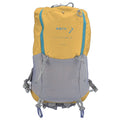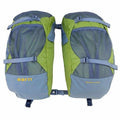57 or 65 Liter Aarn Guiding Light Backpack
- 57 Liters - Short
- 65 Liters - Long
- Small
- Medium
- Large
Checkout securely with


Ultralight
Backpacks
Designed for balance, comfort, and durability

Hiking & Camping Gear
Lightweight and innovative for effortless adventures

Expert
Support
Passionate outdoor enthusiasts helping you choose the right gear
$100 OFF CLOSEOUT SALE!
Developed with NZ climbers in mind and optimized for climbing, skiing, and hiking with trekking poles, the Aarn Guiding Light balance pack allows dynamic movement and superb ability to go just about anywhere, and the Flow Motion harness system is built for maximum agility and performance.


Jenny Loe - John Muir Trail, 2017
FEATURES
Guiding light is one of the best hiking backpacks in that it allows you to stow or remove tools without taking the pack off. The Rope Door located in the section behind your head allows you to put in or roll out rope as needed. It doubles as a hydration port, with an easy access loop for holding your hydration bladder. The Tool Quivers on the sides are great for attaching skiing equipment or for accessibility to ice tools, snow stakes, avalanche probes, trekking poles, and compact tripods for photographers.
Add Balance Gear Racks (see More Accessories tab) to this comfortable backpack to take the weight of climbing hardware off your shoulders when climbing. The new generation 4 model has a revised frame which is lighter & stronger, and also has an improved Multi-Flow pivot position for an easier-to-use hipbelt.
- Pack features two backlengths, each of which can be adjusted up to 15cm, and a Pelvic Form Hipbelt, making the pack usable for people of all shapes and sizes.
- U, Free, Multi, and Flexi-Flow design plus Free-Flow shoulder straps make the backpack exceptionally comfortable, while the several pockets and make organization easy.
SPECIFICATIONS

BALANCE POCKETS
Front Balance Pockets allow for high weights without feeling intrusive. Balance Pockets attach easily to Aarn’s comfortable backpacks and convert easily into a daypack after clipping on the shoulder and sternum straps. Hiking, backpacking, and exploring the outdoors has never been easier!
- Either 10 or 12 liter front Sport-Regular Balance Pockets, or 15 liter or 18 liter Expedition Balance Pockets can be used with this pack. Pockets provide greater stability and balance, and a more upright posture. This translates to much less fatigue and strain.
- Shoulder and sternum straps are included for converting the pockets into a daypack, which is carried on the front of the body for maximum security and easy gear access.
- Front pockets have waterproof Dri-liners, accessible zip flaps to protect items from the rain, and four mesh exterior pockets with compression cords.
- The design of the Front Balance Pockets, which includes four mesh exterior pockets with compression chords, is to provide maximum comfort, organization, and accessibility. Attach to the Aarn balance pack for an unmatched outdoors experience.
(Click on Buttons to See and Evaluate)
- Sport Balance Pockets - Mid-volume balances unobtrusiveness and weight carrying ability
- Expedition Balance Pockets - Large-volume for balancing heavy loads.
MORE ACCESSORIES
(Click on Buttons to Evaluate and Purchase)
These allow you to clip climbing hardware on the larger models with Pelvic Form Hipbelts.
Alternative to sternum straps when Balance Pockets are not used.
Hold tent, poles, foam pad, etc. on pack sides.
Allow skis to be attached to the pack sides and locked to prevent movement
Allow a snowboard to be attached to the pack and locked to prevent movement
DESIGN



FITTING
WHAT MAKES AN AARN PACK DIFFERENT?
| Type: |
Backpack |
|---|---|
| Vendor: | |
| Pack Capacity - Backlength: |
57 Liters - Short, 65 Liters - Long |
| Hipbelt Size: |
Small, Medium, Large |
| SKU: |
GL-S/S-S/S |
| Weight: |
5.04 lb |
SHIPPING, RETURNS, EXCHANGES & REFUNDS
Turnaround All orders are shipped within 48 hours Monday - Friday 8:30 am - 5pm
Carriers We use the following carriers to deliver our orders: USPS UPS FedEx
Order Tracking If the shipping carrier provides a tracking #, we will update your order with the tracking information. Please note that some orders using 1st Class USPS mail will not have tracking numbers.
Shipping Rates The rate charged for the shipping of your order is based on the weight of your products, package size and your location. Before the final checkout page, you will be shown what the cost of shipping will be, and you will have a chance to cancel your order.
FOB Origin All items are sent FOB origin, meaning that the sale is considered complete. The buyer owns the goods as soon as the product leaves Light Hiking Gear's shipping dock or is delivered to the carrier. Thus the buyer of the goods is responsible for any liability during transport/delivery, including damage, loss or theft.
Back Orders If an item goes on back order we will ship you the part of your order that is in stock. When the item becomes available, we will ship you the rest of your order. You will not be charged any additional shipping and handling for the second shipment.
Returns Please email service@LightHikingGear.com to request a return, refund or exchange.
Merchandise that has not been used or altered will be accepted for return or exchange. Before sending a requested exchange to you, we must receive the original item. Refunds will be made in the same form of payment used for the original purchase.
Return of goods for refund or exchange must be in the item's original unused condition, including tags, and be within 30 days of purchase unless there is a manufacturing defect.
Because we provide free shipping for delivery of all orders sent to U.S addresses, we cannot pay the shipping/mailing costs for returns or exchanges. Original shipping costs will be deducted from refunds for returned items, except in the case of defects.
Defective items: If your product fails due to a manufacturing defect, we will repair it without charge or replace it at our discretion. If the customer requests replacement of an identical item due to defect, then Light Hiking Gear will issue a return label or reimburse the customer's shipping costs up to the amount that we originally paid for shipment to the customer, as well as costs to ship the replacement item.






